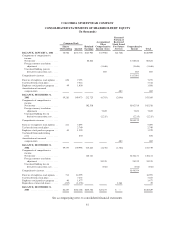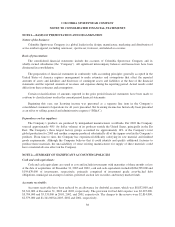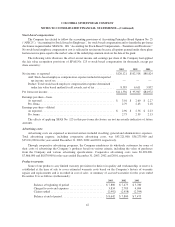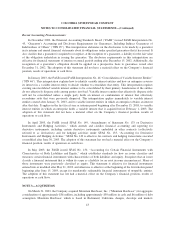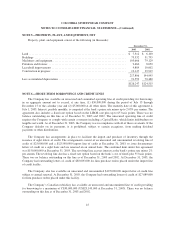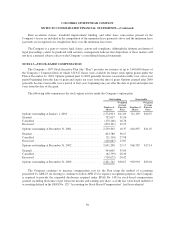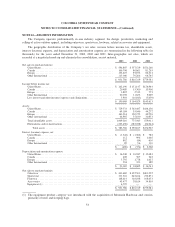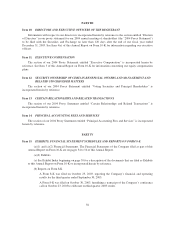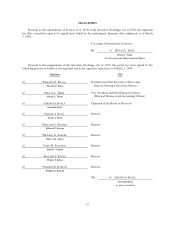Columbia Sportswear 2003 Annual Report Download - page 52
Download and view the complete annual report
Please find page 52 of the 2003 Columbia Sportswear annual report below. You can navigate through the pages in the report by either clicking on the pages listed below, or by using the keyword search tool below to find specific information within the annual report.
COLUMBIA SPORTSWEAR COMPANY
NOTES TO CONSOLIDATED FINANCIAL STATEMENTS—(Continued)
Principal payments due on these notes as of December 31, 2003 were as follows (in thousands):
Year ended
December 31,
2004 ........................................................... $ 4,596
2005 ........................................................... 4,596
2006 ........................................................... 4,596
2007 ........................................................... 3,572
2008 ........................................................... 3,571
Thereafter ....................................................... —
$20,931
NOTE 9—SHAREHOLDERS’ EQUITY
On May 16, 2002, the Company’s shareholders approved an increase in the number of authorized shares of
common stock from 50,000,000 shares to 125,000,000 shares. At December 31, 2003 and 2002, 40,253,235 and
39,737,065 shares of common stock were issued and outstanding, respectively.
On June 9, 1999, the Company’s shareholders approved the 1999 Employee Stock Purchase Plan (“ESPP”).
There are 750,000 shares of common stock authorized for issuance under the ESPP, which allows qualified
employees of the Company to purchase shares on a quarterly basis up to fifteen percent of their respective
compensation. The purchase price of the shares is equal to eighty five percent of the lesser of the closing price of
the Company’s common stock on the first or last trading day of the respective quarter. At December 31, 2003 and
2002, 204,493 and 164,164 shares of common stock, respectively, had been issued under the ESPP.
NOTE 10—INCOME TAXES
The Company applies an asset and liability method for income taxes that requires the recognition of
deferred tax assets and liabilities for the expected future tax consequences of events that have been recognized in
the Company’s financial statements or tax returns. In estimating future tax consequences, the Company generally
considers all expected future events other than enactment of changes in the tax laws or rates. Deferred taxes are
provided for temporary differences between assets and liabilities for financial reporting purposes and for income
tax purposes. Valuation allowances are recorded against net deferred tax assets when it is more likely than not
that the asset will not be realized.
The Company has undistributed earnings of foreign subsidiaries of approximately $49,000,000 at December
31, 2003, for which deferred taxes have not been provided. Such earnings are considered indefinitely invested
outside of the United States. If these earnings were repatriated to the United States, the earnings would be subject
to U.S. taxation. The amount of unrecognized deferred tax liability associated with the undistributed earnings
was approximately $1,000,000 at December 31, 2003. The unrecognized deferred tax liability is the approximate
excess of the United States tax liability over the creditable foreign taxes paid that would result from a full
remittance of undistributed earnings.
In October 2003, the Internal Revenue Service commenced an examination of the Company’s 2001 U.S.
federal income tax return.
The Company receives a U.S. income tax benefit upon the exercise of the majority of its employee stock
options. The benefit is equal to the difference between the fair market value of the stock at the time of exercise
and the option price, times the appropriate tax rate. The Company has recorded the benefit associated with the
exercise of employee stock options directly to shareholders’ equity.
47


